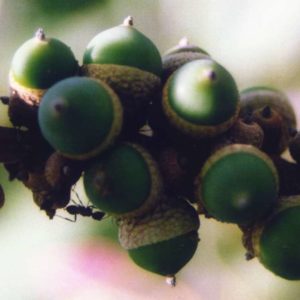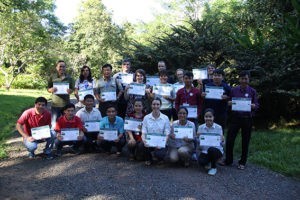Pha Tad Ke recently hosted a week long workshop on the Fagaceae of Indochina. The workshop was funded jointly by Botanic Gardens Conservation International (BGCI) and Flora and Fauna International (FFI), and brought together people from throughout the region to learn and share their expertise. It was the first time PTK has hosted such an event, and it was such a success we hope to hold many similar events in the future.
“Fagaceae” is the name given to the plant family that contains oaks and chestnuts. The family is found throughout the world, with Quercus (the oak genus) being present on almost every continent (not Antarctica). Of the 8 genera found in this family 7 are found in Asia, with 2 only being found in this region – Castanopsis (which includes the commonly cultivated chestnut) and Lithocarpus. Asia is the centre of diversity for this family and probably the area where they first evolved around 100 million years ago. Fagaceae are dominant in many different forest types in Asia and are very important for the forest ecosystem as a whole. Here in Laos we see Castanopsis at lower altitudes and Lithocarpus and Quercus at higher elevations. Many of the nuts are quite tasty, and locals can point you in the direction of edible species easily.

Lithocarpus sp acorns. Photo from Wikimedia Commons.
As well as learning about the biogeography and distribution of Fagaceae, our workshop included a section on how to identify these plants. It’s relatively easy to know you have a plant in the family, working out the genus is do-able, but correctly identifying the species is challenging as there are more than 700 different species in Asia alone! Fortunately, we had the experts on hand to help us out, and our skills at Fagaceae identification are much improved. Participants brought herbarium specimens (dried plant material) with them and we were able to name many of these specimens. This was great because these specimens have now been returned to their home locations with names and will provide a valuable resource for botanists and plant scientists of all kinds.
Another major component of our workshop was learning how to do IUCN Red Listing. This system, set up by the International Union for the Conservation of Nature (IUCN), is used internationally to determine how threatened a species is, and how likely it is to become extinct. The criteria can be applied to any living organism. For example, well known species like tigers and pandas are considered to be “endangered” under the IUCN Red Listing system, because there aren’t many left, and the survival of the species is under serious threat due to hunting and habitat destruction. The same rating is given to rare tree species like rosewood, which is a very high value timber tree that has been logged until there’s little left.
Once given a rating under the IUCN Red List system, it becomes easier to prioritise conservation actions. For example, if you know that a natural area contains 10 tree species rated “endangered” you will push for that to become a national protected area as opposed to a similar location near by that only contains one endangered tree species. Red list assessments are also very useful for informing legislation, policy and raising awareness about species conservation.
Despite the value in such assessments the vast majority of plant species have still not been assessed. Areas where the flora is poorly understood, like Asia, are particularly poorly represented. The training at the workshop taught us all how to do these assessments and how to integrate them into our existing conservation efforts. As part of our learning we assessed 92 tree species from the region, which is a great contribution to global knowledge on these trees. It’s amazing what you can get done when you have the right group of people together!

The workshop participants with their certificates – tired but triumphant!
The third and final component of our week of training focused on biodiversity monitoring. This is the process of determining the status of living organisms and their environment, and then tracking changes to this over time. As with Red Listing, monitoring is important for conservation action. If you don’t know what is happening to a species/environment over time then how can you plan to conserve it? If you have a conservation programme in place, how do you know if it is being effective if you don’t monitor what you’re conserving? With these things in mind we discussed how to create realistic monitoring plans and how to integrate data gathering and monitoring work into our existing field work schedules. This section of the training was based on brief 3 of the Global Tree Campaign’s resources, which can be found here for anyone interested. It has been written for non-specialists, so you don’t need to be a scientist to understand it.
After a successful week of workshop-ing, our minds were tired but we were full of new knowledge and newly inspired. One of the most valuable things to come from training sessions like this is the opportunity to make connections with others working in the same field, and to share our expertise. Aside from doing the Red List assessments for 92 plants we named over 100 herbarium specimens and may have even found a new species amongst the dried material (exciting!)… Stay tuned for more on that!
PTK would like to thank BGCI and FFI for funding this workshop – it would not have been possible without them. Also, a big shout out to the trainers and organisers: Ms Jean Linsky (Organiser, BGCI), Ms Emily Beech (Red Listing trainer, BGCI), Mr David Gill (Monitoring trainer, FFI), Dr Joeri Strijk (Fagaceae ID trainer and Asian Fagaceae expert) and Dr Damian Hinsinger (Fagaceae biogeography trainer).
Text by Bryony Smart, PTK Botanist.
Photo credits:
Lithocarpus acorns: By Ahoerstemeier – Own work, CC BY-SA 3.0, https://commons.wikimedia.org/w/index.php?curid=8497
Other images by Bryony Smart

We held a farewell Baci (traditional Lao ceremony) to wish everyone good luck and safe journeys home.
Share this Post


